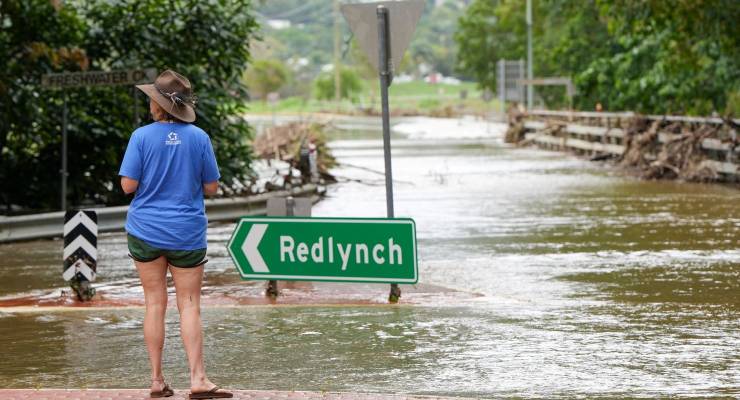
2023 was a year of record-breaking heat, devastating storms and floods, deepening droughts and raging wildfires. These events showed how climate change is affecting the global water cycle and our livelihoods.
Our international team of researchers today released a report, the Global Water Monitor, documenting the impact of the record heat in 2023 on the water cycle. We used data from thousands of ground stations and satellites to provide real-time information on various environmental parameters.
The report summarises conditions and events in 2023 and long-term trends. We found global warming is profoundly changing the water cycle. As a result, we are seeing more rapid and severe droughts as well as more severe storms and flood events.
Scores of countries had record average annual temperatures in 2023. Severe droughts hit three continents. The world’s largest forests suffered, with Canada battling huge fires and the Amazon hit hard by drought.
Heat is drying out the world
The most obvious sign of the climate crisis is the unprecedented heat waves that swept the globe in 2023. Earth’s hottest year on record gave us a glimpse of what a typical year with 1.5 degrees of warming may look like. Global warming consistently more than 1.5 degrees above pre-industrial levels is expected to have extreme and irreversible impacts on the Earth system.
Some 77 countries experienced their highest average annual temperature in at least 45 years. Temperature records were shattered from Canada to Brazil, Spain to Thailand.
The high temperatures were often accompanied by very low air humidity. The relative air humidity of the global land surface was the second-driest on record in 2023.
Rapid drying of farms and forests caused crops to fail and forests to burn. Lack of rain and soaring temperatures intensified multi-year droughts in vulnerable regions such as South America, the Horn of Africa and the Mediterranean.
The past two decades have significantly increased air temperatures and reduced air humidity. This continuing trend toward drier conditions is threatening agriculture, biodiversity and overall water security.
These conditions heighten heat stress and increase the water needs of people, crops and ecosystems.
Scorching conditions inflicted extensive damage on the world’s largest forests. Massive wildfires ravaged Canada during the northern summer. Later in the year the Amazon rainforest and rivers descended into severe drought.
The world’s forests have been soaking up a lot of our fossil fuel emissions. That’s because plant photosynthesis absorbs carbon dioxide from the atmosphere. Large disturbances like fire and drought reduce or even reverse that function.
Water cycle changes fuel intense storms
A change in circulation and sea temperatures in the Pacific Ocean to El Niño conditions influenced the global water cycle in 2023. But this happened against a backdrop of increasing sea surface temperatures due to global warming.
Rising sea surface and air temperatures have been intensifying the strength and rainfall intensity of monsoons, cyclones and other storm systems.
We saw this happen close to home. Cyclone Jasper battered northern Queensland and severe storms formed in south-east Queensland, leaving a trail of destruction. The cyclone moved much slower than expected, causing torrential rains and widespread flooding.
In 2023, we also saw other cyclones behave in unexpected and deadly ways. A cyclone travelled across to New Zealand. The longest-lived cyclone ever recorded battered south-eastern Africa for weeks. And a cyclone developed in the Mediterranean Sea, crossing from Greece to destroy reservoir dams in Libya, killing thousands.
The estimated global damage from cyclones in 2023 surpassed US$45 billion.
Warmer sea temperatures fuel such freak events. As the climate crisis deepens, we can expect more unprecedented storms.
Outlook: 2024 and beyond
At the start of 2024, the greatest risk of developing or intensifying drought appears in Central and South America (except southern Brazil and Uruguay), southern Africa and western Australia.
Regions that received much rainfall towards the end of 2023 are unlikely to develop drought for at least several months. These include the Sahel region and the Horn of Africa, northern Europe, India, China and South-East Asia.
The events of 2023 show how the threat of ongoing climate change to our planet and lives is growing by the year. There were many such events in 2023, and the human and economic toll was large. These events should not be viewed as isolated incidents but as part of a broader emerging pattern.
Globally, the frequency and intensity of rainfall events and flooding are increasing. At the same time, there are also more and faster-developing droughts, or flash droughts, that can cause crop failure and destructive wildfires within weeks or months. With the global food challenge, biodiversity crisis and an extremely urgent need to reduce carbon emissions, these droughts and fires are among our greatest global threats.
Overall, 2023 provided a stark reminder of the consequences of our continued reliance on fossil fuels and the urgent need but apparent inability of humanity to act decisively to cut greenhouse gas emissions.
This article was first published in The Conversation.








Perhaps it’s about time to start thinking about doing something about it at some time in the future.
But no need to rush into anything.
As long as “The Powers that Be” can keep us Peasants and similar inconsequential lifeforms under control.
keep those profits rolling in and those with enough money living well.
Get reelected and feast at the trough,
What’s there to be worried about?
We can solve the problem any time we want, just not yet. It’s a bit like fixing the ozone hole, which we didn’t. And ensuring no child in Australia lives in poverty, which we haven’t. Knowing we could gives us that cuddly safe feeling, while not doing it gives us that lovely infuriated-at-someone-else superiority.
Time to light the methane and boil the breakfast egg from a tortured chook. Might plan the next hol, trouble is I’ve flown all over this planet, and there’s just nowhere else to go.
Ozone hole is starting to reduce. Maggie’s one good gift to the world.
Fortunately all governments started working to reduce CFC’s in the 90s. The same time they completely gave up on reducing the causes of climate change.
I feel that there is an important statistic that never seems to get a mention. The specific heat of air (at standard room temperature and pressure, so it’s going to vary a bit with changes to either) is about 1 Joule per gram per Kelvin. That is, it takes a Joule of energy to raise the temperature of a gram of air by 1 degree Celsius. Or, to flip that, every 1 degree that the temperature rises, a gram of air holds an extra Joule of energy.
The mass of the atmosphere is just over 5 x 10^18 kg. So with each 1 degree rise in temperature the atmosphere now contains 5 x 10^18 kJ of energy. It’s a simple (overly simple) equation, and does not say anything specific about droughts, rainfall, or anything in the way of predictions.
What it does tell you is that for every degree rise in temperature the atmosphere is now holding an extra 5 billion billions of kJ all available to be used for ever more extreme weather. Higher winds, heavier rainfall, sudden and extreme droughts, all of that chaotic behaviour that makes up weather.
Simple maths tells us to do something before we get to the point where skyscrapers are being blown over and there’s no point any more in trying to race in and repair roads before they just get washed away again.
As a scientist, I am appalled at the lack of action by governments, including ours, to put a stop to the burning of fossil fuels. This should have happened decades ago, when evidence of a link between fossil fuel combustion and global heating became clear. As Professor Brian Cox said recently, it is increasingly obvious that we are the only lifeform in the universe capable of communicating complex information and ideas. However, our stubborn refusal to acknowledge the existential threat of global heating may cause our demise. The universe would then be unaware of itself.
That is well put and clear enough to all, of any level, type, class, race…
Moot point. We’re not much more aware of the universe than my dog. And, with or without UFOs, our demise would still leave billions of sentient civilisations out there. All, no doubt, bemoaning the curse of the media.
There’s probably one out there right now waiting for us to drop dead and the nukes to rot away before moving in to our warmer planet, as theirs cools. The 60°ers. From Boiliabum.
Abysmal. thanks for SHARING